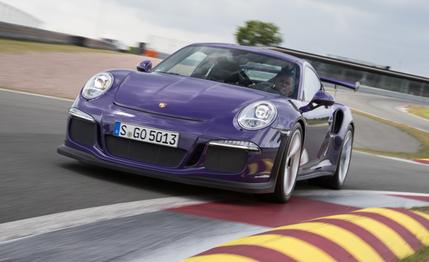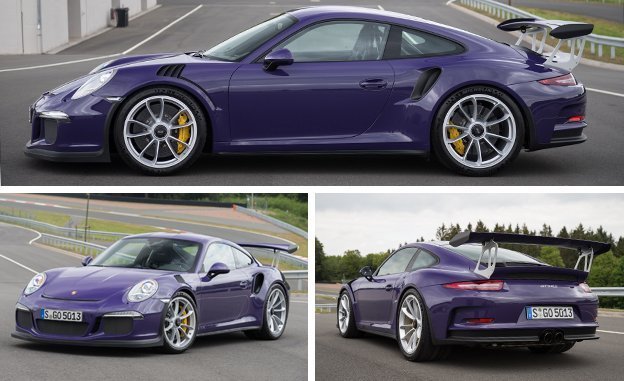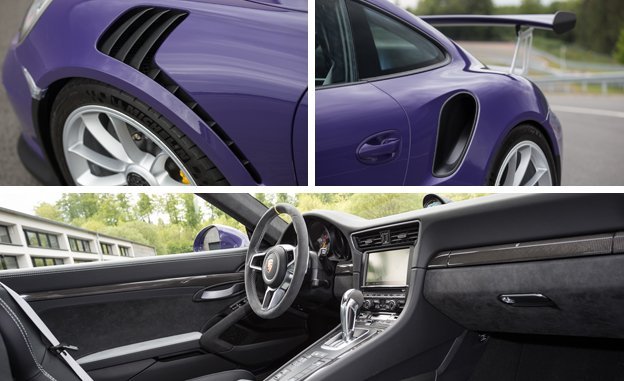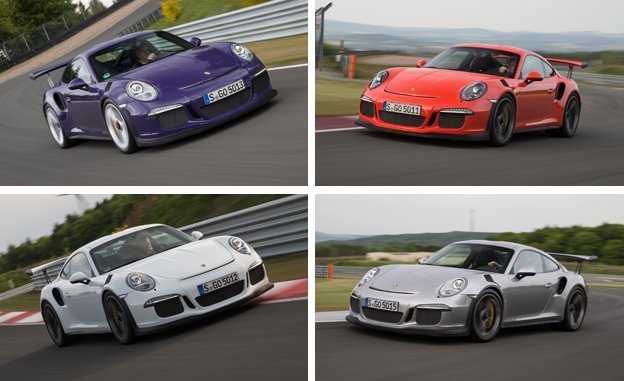 First Drive Review
First Drive Review
We just sat right-seat while rally legend Walter Röhrl drove the new Porsche 911 GT3 RS on the diabolical Bilster Berg racetrack in northern Germany. The lean and lanky Röhrl, now in his late 60s, completes two deceptively fast laps with such nonchalance that he might as well be stirring sugar into a cup of tea. We have entered Walter’s World, and it’s hard to imagine a human better suited to, or more comfortable in, a set of circumstances that could so utterly undo the average person.
Röhrl designed this private racecourse at the behest of a local member of the landed gentry. And it’s every bit as terrifying for mortals as you might expect of a track laid out by a two-time World Rally champ. Its 2.6 miles of blind rises and ridiculous off-camber plunges has earned it the nickname the Little Green Hell, an allusion to the 13 miles of nastiness that is the Nürburgring north loop.

As a senior test driver for Porsche’s GT cars, Röhrl also had input into the development of this, the most intense and track-ready 911. Bewinged, pierced with vents, and crammed full of tire, this is the Porsche that allows any old accountant, surgeon, or writer a glimpse into Walter’s World. You (and we) will surely be slower, more frenzied, and less comfortable than Röhrl while there; but you’ll get a taste. All you need is $180,595.
It rides on rear tires as wide as those of the 918 Spyder hyper-hybrid, fitted to 21-inch rear wheels that redefine the phrase “filling the wheel well.” Its towering rear wing, manually adjustable to three angles of attack, and front fender-top louvers make this road-legal car look every bit the racer. So it is with some relief that we report to you that the car is not at all murderous. In fact, it’s hard to imagine a trustier companion for this particular trial.
The RS is an amalgam of Porsche goodness, starting with a Turbo’s wide rear flanks, an uprated and enlarged naturally aspirated flat-six from the already pretty-darn-special GT3, and a healthy dose of additional aerodynamic and trick-material accouterments.
When we first saw a camouflaged GT3 RS testing on the Nürburgring more than a year ago, we thought it might be a turbocharged GT2 development mule. Nope. Those air inlets just behind the door handles, which would feed intercoolers in the Turbo, are instead used for reconfigured engine-air intakes. They feed air to a version of the GT3 engine that is stroked to 4.0 liters from 3.8. It positively howls up to its 8250-rpm power peak, at which point it’s producing a nice, round 500 horses. That’s a bump of 25 horsepower from the standard GT3. The RS engine also pumps out 338 lb-ft of torque at 6250 rpm, 14 more than the GT3.
The standard GT3 starts at $131,395, about $50,000 less than the RS. Could an extra 25 horsepower possibly be worth almost $50,000? Well, of course, it isn’t in any reasonable world. But that’s not the world in which this story exists. In the world of a racier version of the racy version of a high-performance Porsche, the answer is “yes.” Hell, you could pretty easily spend $50,000 in optional extras for a Cayenne and you’d just end up with a Cayenne, albeit one with leather-covered HVAC vents.

In the GT3 RS, those long intake tracks seem to wrap you in glorious sound. “More race car–like” is the way Porsche describes it. And, how! What price do you put on that? A single run up to its 8800-rpm redline convinced us we’d choose the RS over the slightly pricier 911 Turbo S.
Naturally, buyers are paying not just for the engine enhancements. The GT3 RS is clad in some expensive duds. The trunklid, engine cover, and front fenders are rendered in carbon fiber. The roof is a one-millimeter-thick sheet of magnesium, a novel choice that Porsche says is lighter by almost two-and-a-half pounds than an aluminum roof would be. It’s lighter by 28 ounces than a carbon-fiber roof would be, says the company. Sure, we could have saved more than that by having a lighter breakfast, but—who are we kidding?—we wouldn’t. All in, Porsche claims to have shaved 22 pounds in body-panel weight compared with the GT3. This despite the RS’s wider rear end.
But this is no stripped-out race car. It’s still offered with air conditioning, a nav system, and a stereo. So okay, it has an adjustable pit-lane speed function and straps where interior door handles should be, but those strike us more as theater than necessities. And let’s not forget that, like the GT3, the RS comes only with the seven-speed dual-clutch automatic transmission, at least for now. This car is not just about saving weight; it’s about lapping a road course faster. And the dual-clutch, using the same gear ratios as the standard GT3, undoubtedly makes the RS faster—to say nothing of being nearly foolproof.
At the suggestion of Porsche’s head driving instructor, we drove a few laps in fully automatic mode without even engaging the PDK Sport button and while ignoring the paddle shifters, and the transmission ripped off perfectly timed shifts, every time. It’s not as involving as a manual transmission, of course, but around this track there are plenty of other things on which to concentrate.

Mostly we were concentrating on having fun without ending our day in a wall. This we accomplished thanks to the RS’s rock-steady stability, neutral handling, and the otherworldly grip of its Michelin Pilot Sport Cup 2 tires (sized 265/35-20 front and 325/30-21 rear). According to Porsche, the big front splitter and louvered front fenders help deliver 243 pounds of downforce at 186 mph. And that big rear wing can deliver 485 pounds of downward pressure at the same speed. The RS wears GT3-spec springs and anti-roll bars, and it has retuned electronically controlled dampers. The front suspension is adjustable for camber, caster, and ride height. Both front and rear anti-roll bars are also adjustable. There’s some rear-axle steering and an electronically controlled limited-slip differential. That amounts to a hell of a lot of technology for a track-day tool, but it all feels perfectly natural, never giving the driver the sense that it’s second-guessing him.
And, at least on the smooth, well-maintained German public routes we traveled, the RS is a totally viable road car, too. It never feels darty, harsh, or annoyingly out of its element. The only indications that the car is itching to hit the track are the stiff racing buckets (18-way power-adjustable seats are a no-cost option) and the chorus of noises the car makes—the scruffing sound of cold ceramic brakes (a $9210 option), the bit of transmission rattle at idle, and the bellowing engine.
If you visit Germany you might see Röhrl driving around in the silver GT3 RS he anticipates soon adding to his fleet. He will no doubt be looking relaxed and will possibly be on his way to the track.